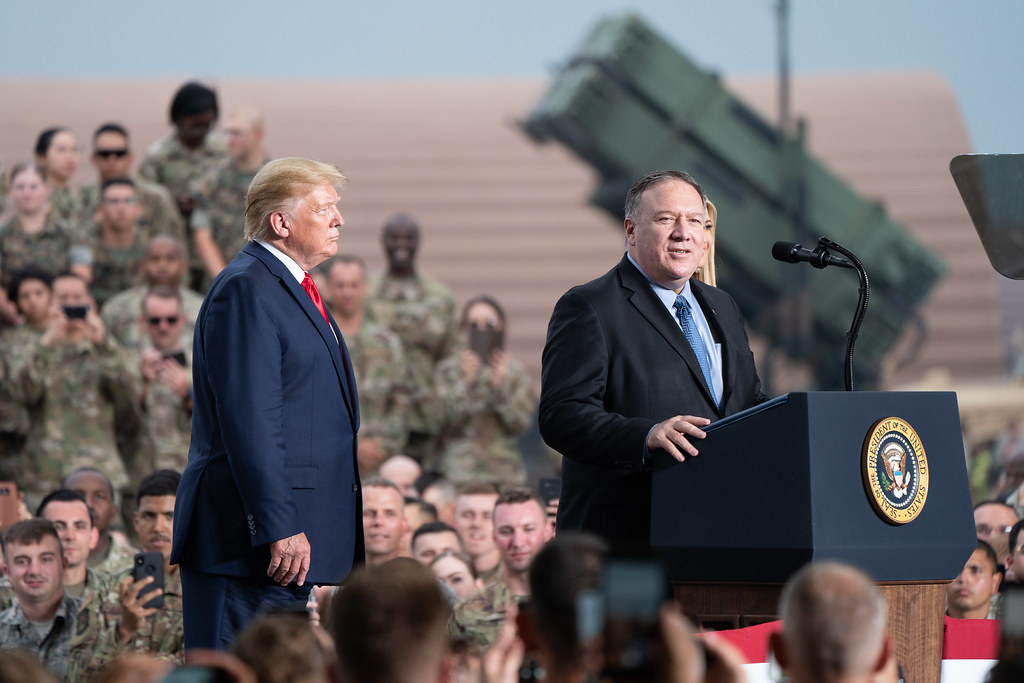Legal Issues Implicated By Trump’s Firing of the State Department Inspector General
The firing is almost certainly lawful, but it is unclear whether the president’s chosen replacement can immediately assume the role.

Published by The Lawfare Institute
in Cooperation With

On Friday, May 15, President Trump announced in a letter to Speaker of the House Nancy Pelosi that he was firing State Department Inspector General Steve Linick. Several sources have reported that Stephen Akard, the Senate-confirmed director of the State Department’s Office of Foreign Missions, will replace Linick in an acting capacity. Trump’s firing of Linick is almost certainly lawful. However, it is unclear whether Trump can immediately replace Linick with Akard, if that is the plan.
1. Is the Firing Lawful?
Bracketing for a moment the question of retaliation, which we discuss briefly below, Trump’s firing of Linick appears to be lawful. The State Department inspector general is governed by the Inspector General Act of 1978, as modified by the Inspector General Reform Act of 2008 (IGRA). The amended statute states that an inspector general “may be removed from office by the President” but requires the president to “communicate in writing” to both houses of Congress “the reasons for any such removal” at least 30 days before the removal. The reason that Trump provided for the removal in his letter to Pelosi was that he “no longer” had the “fullest confidence” in Linick. This was the exact reason and language Trump used when he fired Michael Atkinson as inspector general of the intelligence community in April.
It is also the precise reason and language that President Barack Obama used in 2009 when he fired Gerald Walpin as inspector general of the Corporation for National and Community Service (CNCS), though the Obama White House within a week after the termination provided detailed reasons for the firing. After Obama fired Walpin, Walpin sued the CNCS for reinstatement. The federal district court in 2010 rejected Walpin’s request for mandamus relief on the grounds that he lacked a cause of action. Part of Judge Richard Roberts’s reasoning was that in complaining “that the President’s rationale [for the firing] was insufficient, Walpin fails to show how the [Inspector General Act] provides any sort of criteria that would allow a court to make that determination.” The court also noted that the Senate report accompanying the IGRA indicated that Congress rejected a higher “for cause” removal standard, hoped that the notice provision alone would deter improper firings, and stated that the notice provision “does not alter the President’s ultimate authorities with respect to Executive Branch employees.”
In short, the standard for firing the State Department inspector general is a low one, and Trump’s thin reason almost certainly suffices—especially against the background of the president’s constitutional authority to fire presidential appointees at will absent a statutory provision to the contrary.
This conclusion does not extend to potential legal constraints related to the possibility that Linick was fired in retaliation for investigating Secretary of State Mike Pompeo. The State Department inspector general statute, at 22 U.S.C. § 3929(a), specifies that “[n]either the Secretary of State nor any other officer of the Department shall prevent or prohibit the Inspector General from initiating, carrying out, or completing any audit or investigation, or from issuing any subpoena during the course of any audit or investigation.” This may have been the provision that Rep. Eliot Engel and Sen. Bob Menendez had in mind when they stated that Linick’s firing “may be an illegal act of retaliation.” It is unclear how § 3929(a) intersects with the termination provision of the inspector general statute, and in any event the statute limits the secretary of state and not the president. But Pompeo’s reported recommendation to fire Linick, if substantiated, may implicate the State Department inspector general statute independent of the legality of firing itself.
2. Can President Trump Place Linick on Administrative Leave?
The IGRA requires notice to Congress “30 days before the removal.” This implies that Linick must remain State Department inspector general for almost a month longer.
One partial way around this conclusion would be for Trump to place Linick on administrative leave during that period prior to his formal termination and thus effectively (even if not technically) remove him from office immediately. That is what Trump did with Atkinson in April. It is what the State Department spokesperson might have implied when he or she recently said that Akard “will now lead the Office of the Inspector General at the State Department.” And it is also what Obama did with Walpin in 2009. According to Walpin (page 2) and a Republican staff report on the Walpin firing (page 44), Walpin was placed on administrative leave immediately upon notice of the termination and not permitted to return to his office.
At first glance, the placement of a terminated inspector general on administrative leave for the 30-day period appears to violate the statutory requirement of notice to Congress 30 days before removal. But in the 2010 Walpin decision, Roberts provided reasons why this move may not violate the 30-day rule. He explained that the IGRA states that “[n]othing in this subsection shall prohibit a personnel action otherwise authorized by law, other than transfer or removal.” He noted that Office of Personnel Management regulations on civil service employment define “removal” as “the involuntary separation of an employee from employment with an agency.” And he noted that courts had ruled—in contexts not concerning an inspector general—that placing an employee on administrative leave did not amount to removal. For these reasons, placing a terminated inspector general on administrative leave during the 30-day period is not a “removal” and thus does not violate the inspector general statute’s notice requirement. (The House’s latest coronavirus relief bill seeks to address this issue by adding the placement of an inspector general on “paid or unpaid non-duty status” to the list of personnel changes that require congressional notification 30 days before taking effect.)
In sum, it appears that the IGRA prohibits the Trump administration from formally terminating Linick for almost a month. If Linick is placed on administrative leave, that can be construed to be consistent with the statute’s 30-day rule on the ground that the leave technically does not constitute removal. This conclusion raises separate issues for Trump’s apparent replacement of Linick with Akard.
3. Can Akard Replace Linick Immediately?
A State Department spokesperson said that Akard would replace Linick and become acting inspector general “now,” which implies immediate replacement. But as of this writing it remains unclear whether Akard will assume the acting position immediately or after the 30-day period. There is a recent precedent, however. When Trump fired Atkinson from the intelligence community inspector general slot in April, he replaced him immediately with Thomas Monheim, who at the time was the general counsel of the National Geospatial-Intelligence Agency. If something similar happens here, would it be lawful?
The answer turns on the intersection of the IGRA and the Federal Vacancies Reform Act (FVRA), and is complicated—too complicated to sort out definitively here. But here are the issues.
Recall that to make it possible for Linick to be placed on administrative leave for 30 days consistent with the 30-day notice requirement of the IGRA, we probably need to conclude that Linick has not been removed from his inspector general position for 30 days. Considered alone, that would seem to make it impossible for Akard to replace him during that period, since the slot has technically not been vacated.
But the FVRA has different criteria for when an office is vacant and can be filled. It allows a president to fill Senate-confirmed positions with certain defined persons when the person confirmed for the position “dies, resigns, or is otherwise unable to perform the functions and duties of the office.” Akard satisfies one of the defined replacement criteria—he was confirmed by the Senate for a different slot. But is Linick “otherwise unable to perform the functions and duties of the office”?
We have found no case law on the question of whether someone on administrative leave is unable to perform the functions and duties of the office for purposes of the FVRA. For a “normal” administrative leave for sickness or temporary absence, the answer is probably yes. The reason is that the FVRA likely covers both temporary and permanent vacancies, as the Office of Legal Counsel ruled in a 2017 memo. That interpretation seems sound. The preceding Vacancies Act explicitly listed “sickness” as one of the conditions under which the president could temporarily fill a vacant office, and the FVRA’s legislative history indicates that the FVRA was only intended to expand that act’s reach. As a result, it seems likely that the temporary nature of administrative leave by itself poses no bar to an FVRA appointment.
Whether an imposed administrative leave following a notification of presidential firing counts as a vacancy under the FVRA turns on the much-mooted question of whether someone fired by the president is “unable” to serve under the FVRA and thus can be replaced under the statute. The Office of Legal Counsel has taken the position that a presidential firing implicates the FVRA and allows the president to replace the fired officer. The Office of Legal Counsel’s main arguments are that the bill’s sponsor suggested on the Senate floor that the FVRA would reach firings and that “troubling” practical consequences would result if it did not. At least one federal district court has disagreed with this interpretation in dicta, and one of us recently argued that the Office of Legal Counsel’s view is wrong because it misinterprets the act’s legislative history, improperly reads its text and structure, and overlooks its historical context.
But even assuming the Office of Legal Counsel is right, there is still the question in the present context of how to reconcile its interpretation of the FVRA with the more specific and later-enacted IGRA. The IGRA does not allow Linick to be removed for 30 days, and Trump can only place Linick on administrative leave if he does not formally remove him. The statutory inability to remove Linick under the IGRA might control over an interpretation of the more general and earlier-enacted FVRA that allows Trump to replace Linick due to his being on administrative leave. And even if the FVRA is interpreted to allow Linick to be replaced immediately under its terms, the replacement still might independently violate the IGRA’s 30-day rule.
As we said, it’s complicated.





.png?sfvrsn=4156d4f8_5)
